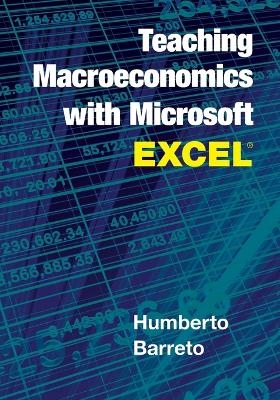
Teaching Macroeconomics with Microsoft Excel®
Cambridge University Press (Verlag)
978-1-107-58498-3 (ISBN)
Humberto Barreto gives professors a simple way to teach fundamental concepts for any undergraduate macroeconomics course using Microsoft Excel® with Excel workbooks and add-ins and videos freely available on his university website. The Excel files are designed to be used by students with any textbook, and have been used many times by the author in his own teaching. Each Excel workbook contains links to short screencasts, around five to ten minutes, that show the cursor and typing as the file is manipulated with narration that walks the student through the steps needed to complete a task. The book shows professors a simple way to present macroeconomic models and incorporate data into their courses.
Dr Humberto Barreto earned his PhD from the University of North Carolina, Chapel Hill in 1985 with a specialization in the history of economic thought. In his teaching and writing, Barreto applies a pedagogical philosophy that eschews formalism and abstraction in favor of concrete problems and hands-on learning. He shows students how economists think, manipulate models, and use data. Barreto has previously been a Fulbright Scholar in the Dominican Republic, has won several teaching awards, and has given workshops all over the world on how to improve the teaching of economics and econometrics.
Preface; Software requirements and opening a macro-enhanced workbook; Introduction: why simulation and Excel?; Part I. Charting in Excel: 1.0 Introduction; 1.1 Simple scatterplot and double y charts: HowToChart.xls; 1.2 The shaded (recession) chart: recessionChart.xls and EconChart.xla (add-in); 1.3 Summary; Part II. Economic Growth Literacy: 2.0 Introduction; 2.1 Setting the scene; 2.2 Attaining economic growth literacy: MaddisonData.xls; 2.3 Summary; Part III. The Solow Model: 3.0 Introduction; 3.1 Capital accumulation: KAcc.xls; 3.2 The golden rule: GoldenRule.xls; 3.3 Population growth: Population.xls; 3.4 Technological progress: TechProgress.xls; Part IV. Macro Data via FRED in Excel: 4.0 Introduction: FRED.xla (add-in); 4.1 GDP: GDP.xls; 4.2 Unemployment: Unem.xls; 4.3 Inflation: Inflation.xls; 4.4 Money: Money.xls; Part V. The Keynesian model: 5.0 Introduction; 5.1 Keynesian cross: KCross.xls; 5.2 Money market: MoneyMarket.xls; 5.3 The ISLM model: ISLM.xls; 5.4 The ISLMADAS model: ISLMADAS.xls; 5.5 Summary; Part VI. Epilogue.
| Erscheinungsdatum | 02.04.2016 |
|---|---|
| Zusatzinfo | 28 Halftones, unspecified |
| Verlagsort | Cambridge |
| Sprache | englisch |
| Maße | 176 x 253 mm |
| Gewicht | 380 g |
| Themenwelt | Informatik ► Datenbanken ► Data Warehouse / Data Mining |
| Wirtschaft ► Volkswirtschaftslehre ► Makroökonomie | |
| ISBN-10 | 1-107-58498-1 / 1107584981 |
| ISBN-13 | 978-1-107-58498-3 / 9781107584983 |
| Zustand | Neuware |
| Informationen gemäß Produktsicherheitsverordnung (GPSR) | |
| Haben Sie eine Frage zum Produkt? |
aus dem Bereich


